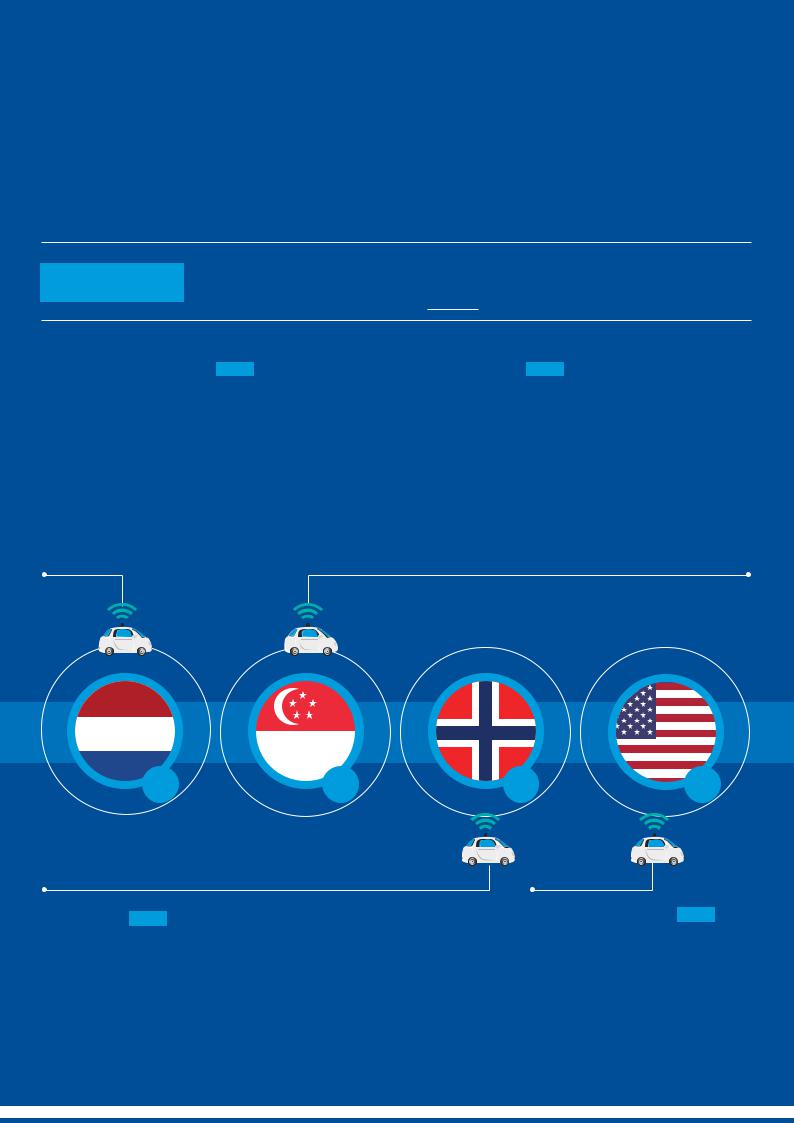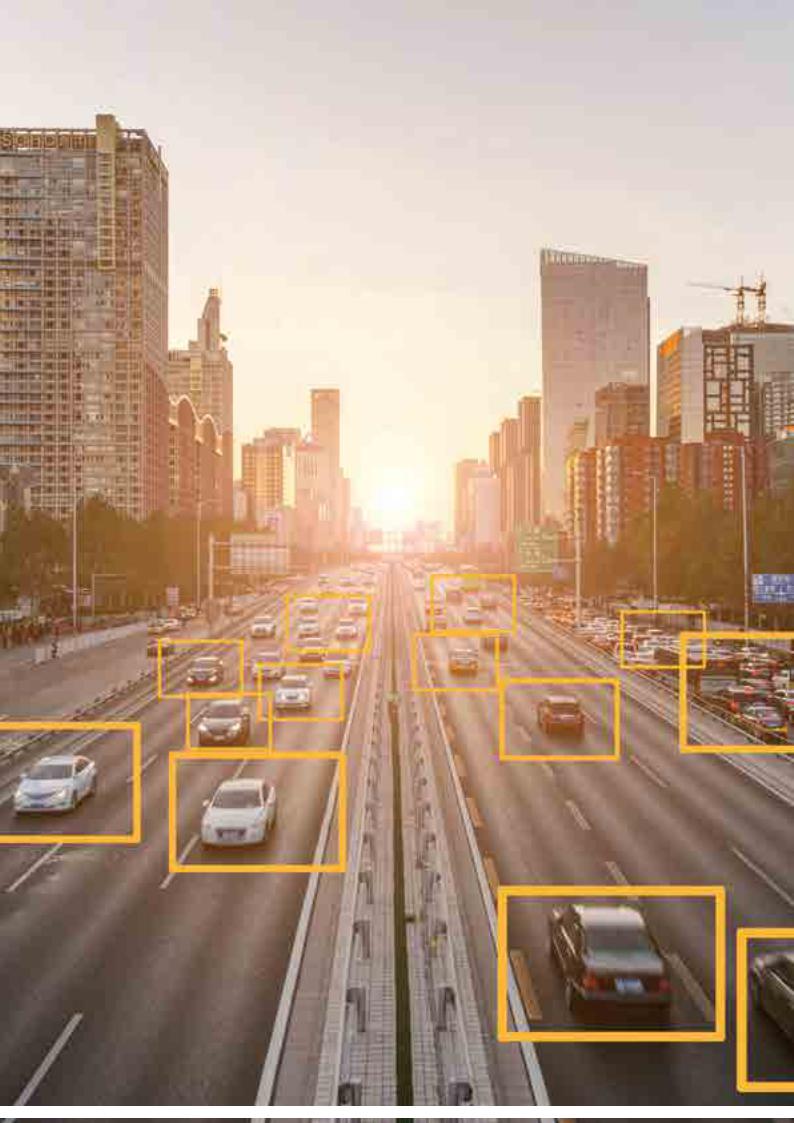
- •Foreword
- •Milestones
- •Executive summary
- •National Profiles
- •The road ahead
- •Preparation and Authorship
- •Acknowledgments
- •List of Acronyms
- •Executive Summary
- •Table of Contents
- •List of Figures
- •List of Tables
- •1 Introduction
- •2 Installation Trends
- •3 Industry Trends
- •4 Technology Trends
- •5 Performance Trends
- •6 Cost Trends
- •7 Wind Power Price Trends
- •8 Policy and Market Drivers
- •9 Future Outlook
- •References
- •Appendix: Sources of Data Presented in this Report

vk.com/id446425943
Executive summary
This edition of the AVRI assesses 25 countries on 25 different variables, organized into four pillars.
Methodology Four of the variables are scored for this index by KPMG International and ESI ThoughtLab; one uses a consumer survey conducted for this report; and the rest use existing research by KPMG and
other organizations. Full details are in the Appendix.
The Netherlands Page 14 |
Singapore Page 15 |
—The AVRI’s leading country is working with neighbors to adopt AV technology for freight, with a plan to launch platoons of more than 100 driverless trucks on major routes from Amsterdam to Antwerp and Rotterdam to the Ruhr valley.
—It is introducing new laws that will encourage AVs, something also pursued by the UK, Australia and France among others.
—The Dutch government is taking an active role in AV safety and legal issues, with the infrastructure minister announcing a ‘driving license’ for self-driving cars in a March speech.
—With a leading university, Singapore has created a test town for driverless vehicles complete with traffic lights, bus stops, skyscrapers and a rain machine to recreate its extremely wet tropical weather.
—Next year, it will introduce self-driving minibuses in several areas, including a university campus — an approach already taken in Norway and France.
—Singapore, along with Hungary, leads a specific measure on having a single government organization that deals with AVs, which improves AV coordination and reduces confusion around who does what.
01 |
02 |
Norway Page 16
—The country legalized AV testing on public roads in January 2018, giving clarity for providers and leading to trial bus services in several locations.
—As a result of significant tax breaks, 40 percent of new cars sold in Norway are electric, many having some autonomous functionality.
03 |
04 |
United States Page 17
—Individual states including Ohio, Michigan and Massachusetts are working to encourage AV development and adoption by opening access to roads and setting up a single coordinating organization.
102019 Autonomous Vehicles Readiness Index
©2019 KPMG International Cooperative (“KPMG International”). KPMG International provides no client services and is a Swiss entity with which the independent member firms of the KPMG network are affiliated.

vk.com/id446425943
Also noted
—A new measure on government data sharing, reflecting the importance of this in the development of AVs, is led by the UK (7th overall).
—Several countries enjoy a dynamic business ecosystem with a focus on AVs, but Israel (14th overall) gains top scores in the AVRI’s technology and innovation pillar through the outstanding performance of its sector.
—The AVRI’s newly introduced consumer survey measuring enthusiasm for AVs is led by India (24th overall) and Mexico (23rd overall), suggesting that countries currently lacking good road transport may be particularly keen to adopt AVs.
05
Sweden Page 18
—The country’s cutting-edge work on freight includes a road that charges electric trucks as they drive over it and pilot use of an AV truck to link two logistics centers.
Key insights for governments
Advanced AV markets could invest more in technology and innovation:
Top ranked countries could far outpace others if they focused on Pillar 2 (technology and innovation); in particular, investing in AV-related firms and R&D, industry partnerships, and an innovation-friendly business environment.
Countries leading in technology and innovation
could work on achieving greater policy and institutional clarity:
Countries that lead in technology and innovation tend to have mid-level scores in their AV regulatory environment and institutions. Adapting and revisiting regulations and establishing an AV-focused institution could take these countries to the top of the rankings.
Most countries that do well on infrastructure
readiness could reform their policy and
legislative environment:
Six of the 10 countries that lead the world on infrastructure readiness — Australia, Austria, Japan, South Korea, Sweden, and the UAE — do not feature in the top 10 for the policy/legislative environment. To improve their overall ranking they could work on establishing new AV regulations and institutions.
Less-developed AV markets could take advantage
of higher consumer interest in AVs if other areas, including policy and technology, are addressed:
In general countries with the lowest overall scores have the highest scores for positive consumer sentiment about AVs. These countries would rise quickly in the rankings if governments actively developed other pillars.
2019 Autonomous Vehicles Readiness Index 11
© 2019 KPMG International Cooperative (“KPMG International”). KPMG International provides no client services and is a Swiss entity with which the independent member firms of the KPMG network are affiliated.

vk.com/id446425943
122019 Autonomous Vehicles Readiness Index
©2019 KPMG International Cooperative (“KPMG International”). KPMG International provides no client services and is a Swiss entity with which the independent member firms of the KPMG network are affiliated.

vk.com/id446425943
National profiles
|
|
|
|
|
|
Policy and |
Technology and |
Infrastructure |
Consumer |
||
legislation |
innovation |
|
acceptance |
||
2019 Autonomous Vehicles Readiness Index 13
© 2019 KPMG International Cooperative (“KPMG International”). KPMG International provides no client services and is a Swiss entity with which the independent member firms of the KPMG network are affiliated.

vk.com/id446425943
1 The Netherlands
Policy and |
5 |
Technology and |
10 |
Infrastructure |
1 |
Consumer |
2 |
legislation |
innovation |
acceptance |
|||||
|
|
|
|
|
|
|
|
The Netherlands retains its lead by doing many things consistently well, including investigating AVs’ use in freight and logistics and passing new legislation.
The Netherlands, which again leads the AVRI, is an example of how to ready a country for AVs by performing strongly in many areas. It leads the index’s infrastructure
pillar, is ranked second on consumer acceptance and is fifth on policy and legislation. The country also scores highly on many individual measures, including supportive regulations, road infrastructure quality, exposure to AV testing and market share of EVs.
This balanced approach is shown in the way the Dutch government is considering the potential to use AVs in freight, while working to improve safety and enhancing the legal framework.
On freight, it plans to have dozens of driverless delivery trucks operating closely together on international highways. In a March 2018 speech, Dutch infrastructure minister Cora van Nieuwenhuizen said the country will work with Germany
and Belgium to introduce ‘truck platooning’ along the ‘Tulip corridors’ from Amsterdam to Antwerp and Rotterdam to the Ruhr valley, with the aim of enabling convoys of at least 100 trucks and eventually self-driving vehicles at night.28 She also said that she would work to connect vehicles using 5G technology and install 1,200 smart traffic lights.
This would build on the Netherlands’ existing leading status on availability of EV charging stations, something also recognized in this index.
The ministry also announced a legal framework for autonomous driving. The Experimenteerwet zelfrijdende auto (law governing the experimental use
of self-driving vehicles) was approved by the House of Representatives in April 2018 and the Dutch Senate in September 2018. It allows experiments with AVs on public roads without drivers in vehicles, although they must be monitored remotely.29
The Netherlands are also preparing a Driving License for a Vehicle. This is being developed in cooperation between the Dutch Vehicle Authority (RDW), the main road authority (Rijkswaterstaat) and the central office for driving exams (CBR). The approach focuses on the extent to which a vehicle can produce safe and predictable automated
driving behavior that aligns as closely as possible to human performance in an open traffic system. Finally, the
Netherlands are working on a “Vehicle Safety & Security Framework (VSSF)” to be able to assess the robustness of in-vehicle software.
As well as freight and private cars, Dutch companies are working on the potential for AVs in private industrial environments with foreign
manufacturing and logistics firms.30 Such uses may precede AVs on urban Dutch roads, which are much busier than in the US and other countries: “We have a lot of bicycles,” points out Stijn de Groen, Manager Digital Advisory, Executive for Automotive, KPMG in the Netherlands. “In urban, crowded areas it will be very difficult to start autonomous driving.” As a result, it may make more sense to keep transport modes separate rather than integrating AVs to work there.
“The Netherlands is spreading its AV bets across projects including truck platooning pilots, public transport in airports and transporting containers in harbors,” adds Loek Kramer, Sector Lead for Automotive, KPMG in the Netherlands, summing up the Dutch approach of looking for opportunities to use AVs across road transport, rather than just for cars.
Electric vehicle charging stations — score by country (top 5)
The Netherlands
1.00
Norway
0.52
South Korea
 0.26
0.26
China
0.22
Germany
 0.16
0.16
Source: International Energy Agency, 2017
Consumer adoption of latest technology — score by country (top 5)
The Netherlands
1.00
Sweden
0.97
United States
0.97
United Kingdom
0.96
Singapore
0.92
Source: World Economic Forum, Global Competitive
Index 2018
 The Netherlands is spreading its AV bets across projects including truck platooning pilots, public transport in airports and transporting containers in harbors.
The Netherlands is spreading its AV bets across projects including truck platooning pilots, public transport in airports and transporting containers in harbors. 
— Loek Kramer
Sector Lead for Automotive, KPMG in the Netherlands
Bio

142019 Autonomous Vehicles Readiness Index
©2019 KPMG International Cooperative (“KPMG International”). KPMG International provides no client services and is a Swiss entity with which the independent member firms of the KPMG network are affiliated.

vk.com/id446425943
2 Singapore
Policy and |
1 |
Technology and |
15 |
Infrastructure |
2 |
Consumer |
1 |
legislation |
innovation |
acceptance |
|||||
|
|
|
|
|
|
|
|
The government is positioning the city-state as a center for AV development with the deployment of a simulated urban test-bed and plans for driverless buses.
Singapore leads the policy and legislation and consumer acceptance pillars, and is second only to the Netherlands on infrastructure. Its government is working hard to consolidate the city-state’s position as a center for AVs. It opened the Centre of Excellence for Testing and Research of Autonomous Vehicles at Nanyang Technological University (CETRAN) in November 2017,31 which includes bus stops, traffic lights, skyscrapers, hills and a rain-making machine to allow realistic testing. Data gathered from this facility has assisted the government with developing Technical Reference
68 (TR 68), which is a set of national standards aimed at promoting the safe deployment of fully driverless vehicles in Singapore. Additionally, CETRAN
is collaborating with The Netherlands Organisation for Applied Scientific Research (TNO) on accelerating the safe introduction of AVs in both countries.
Singapore has also announced that three areas, Punggol, Tengah and the Jurong Innovation District, will use driverless buses and shuttles for off-peak and on-demand commuting from 2022. In November 2018, a bus operator announced a year-long trial of a self-driving shuttle service at the
National University of Singapore’s Kent Ridge campus, starting in March 2019 and operating on actual roads, although it will only carry passengers after initial tests are complete.32
“The government is very proactive in thinking about the future of mobility. It is seriously investigating the possibilities as well as preparing for a regulatory environment that will
facilitate a future that is autonomous,” says Satya Ramamurthy, Partner, Head of Infrastructure, Government and Healthcare, KPMG in Singapore.
Singapore ranks relatively low on technology and innovation, at 15th of 25. Ramamurthy says Singapore’s lack of conventional automotive manufacturing may prove to be a strength in developing EVs and AVs, as they use a substantially different set of components. This seems to be validated by UK-founded home appliances manufacturer Dyson’s announcement in 2018 that it would open a new factory in Singapore focused on building electric vehicles, with a prototype expected in 2020. Dyson will also move its corporate head office to the city-state, although
much research and development work will stay in Britain.33 Ramamurthy adds that the relatively low number of electric charging points is presently
a weakness, but that electricity providers and others are planning to install more of these.
Singapore taxes private cars heavily, which provides a way to promote AVs — at a cost. “Effectively the pricing is done to discourage people from driving,” says Ramamurthy. “That brings with it a whole set of opportunities.” At present, around two-thirds of the price of a car is tax. “There is a lot of policy room for the government to do things to promote adoption, should it wish,” he says.
AV department within government — score by country (top 5)
Singapore
1.00
Hungary
1.00
Austria
0.93
New Zealand
0.93
United Arab Emirates
0.93
Source: KPMG International, 2019
Availability of high-performance mobile internet — score by country (top 5)
Singapore
1.00
Norway
0.89
Australia
0.86
New Zealand
0.82
Finland
0.80
Source: GSMA Global Connectivity Index, 2017
 The government is very proactive in thinking about the future of mobility. It is seriously investigating the possibilities as well as preparing for a regulatory environment that will facilitate a future that is autonomous.
The government is very proactive in thinking about the future of mobility. It is seriously investigating the possibilities as well as preparing for a regulatory environment that will facilitate a future that is autonomous. 
— Satya Ramamurthy
Partner, Head of Infrastructure,
Government and Healthcare, KPMG in Singapore
Bio

2019 Autonomous Vehicles Readiness Index 15
© 2019 KPMG International Cooperative (“KPMG International”). KPMG International provides no client services and is a Swiss entity with which the independent member firms of the KPMG network are affiliated.

vk.com/id446425943
3 Norway
Policy and |
7 |
Technology and |
2 |
Infrastructure |
7 |
Consumer |
3 |
legislation |
innovation |
acceptance |
|||||
|
|
|
|
|
|
|
|
Following the legalization of AV testing in January, several cities now have driverless minibus services and Norway is also working on truck platooning.
On 1 January 2018, Norway legalized AV testing on public roads,34 and operators have started small-scale autonomous bus services as a result. In May, a Stavanger transport provider gained the right to run driverless minibuses, and from June
to December 2018 it ran a free service in Forus.35 However, initial regulations meant there was always an employee on-board who could apply a brake, only six passengers were allowed and the maximum speed was 7.5mph (12kph).36
Ruter, the mass transit provider for Oslo, announced in October 2018 it is starting similar tests with a Danish company, with the aim of having 50 such minibuses in use by 2021.37 Elsewhere, the national
road administration has been testing automated truck platooning in the north of Norway, and pilots of autonomous taxis are set to start in
2019. Norway has a specialist supplier in this area, Applied Autonomy.38 Such work is reflected in Norway’s strong performances in both the technology and innovation pillar, where it is second, and consumer acceptance, where it is third.
Ståle Hagen, Director, Head of Transport and Mobility, KPMG in Norway, says the bus tests involve a variety of environments, including business parks, urban streets and
even a service from a shopping center to a beach.39 “The feedback on AV technology has been quite positive. Passengers are not afraid of using this kind of transport,” he says. Familiarity is developing for another reason: “Fifty percent of all the cars sold in the Oslo region are now electric and these cars are prepared for autonomous driving.”
Norway has by far the highest market penetration of EVs in the index, contributing to its second place in the technology and innovation pillar.
Ketil Marcussen, Partner, Infrastructure Sector, KPMG Norway, says this is due to generous tax breaks, exemptions from road tolls and parking charges, access to bus lanes, free charging stations and the country’s cheap home electricity.
Availability of the latest technologies — score by country (top 5)
Finland
1.00
Norway
0.97
Israel
0.95
Sweden
0.94
United States
0.93
Source: World Economic Forum Networked Readiness
Index, 2018
Market share of electric cars — score by country (top 5)
Norway
1.00
Sweden
 0.16
0.16
The Netherlands
 0.07
0.07
China
 0.06
0.06
United Kingdom
 0.04
0.04
Source: International Energy Agency, Global EV outlook 2018.
 The feedback on AV technology has been quite positive. Passengers are not afraid of using this kind of transport. Fifty percent of all the cars sold in the Oslo region are now electric and these cars are prepared for
The feedback on AV technology has been quite positive. Passengers are not afraid of using this kind of transport. Fifty percent of all the cars sold in the Oslo region are now electric and these cars are prepared for
autonomous driving. 
— Ståle Hagen
Director, Head of Transport and Mobility, KPMG in Norway
Bio

162019 Autonomous Vehicles Readiness Index
©2019 KPMG International Cooperative (“KPMG International”). KPMG International provides no client services and is a Swiss entity with which the independent member firms of the KPMG network are affiliated.

vk.com/id446425943
4 United States
Policy and |
9 |
Technology and |
3 |
Infrastructure |
8 |
Consumer |
6 |
legislation |
innovation |
acceptance |
|||||
|
|
|
|
|
|
|
|
The US is home to the world’s leading AV companies and a lot of
testing work, but the lack of a strong national approach means individual states have to work hard to attract AV businesses.
The United States (US) is home to companies that lead the world in AV development, while the country’s mainstream vehicle makers are working hard to establish AV fleet and ride-hailing services. This contributes to strong US performance in the technology and innovation pillar, where it is third. It moves from third to fourth overall as a result of Norway joining the AVRI, and scores less well on infrastructure, where it is eighth, and policy and legislation, where it is ninth.
The US Department of Transportation published Automated vehicles 3.0 detailing its approach to AVs in October 2018.40 The report’s principles include prioritizing safety; remaining technology neutral; preparing for automation through guidance and pilot programs; and protecting and enhancing freedoms enjoyed by Americans — such as driving their own vehicles, emphasizing that AVs will operate alongside humandriven motorized vehicles and other road users.
The document also says the department “will encourage a consistent regulatory and operational environment” across the US. However, states and cities have significant control of transport work, and differences in approach can be an
advantage for suppliers according to Ted Hamer, Managing Director and Head of Mobility, KPMG in the US. “If one state is really tight in its restrictions and another isn’t, you have the ability to adapt and to move around,” he says, whether for testing, manufacturing
or deployment. Arizona had broader rules on AVs, leading to it being used for several pilot projects, although it has tightened these since the Uber accident in May.
Hamer adds that some states do an excellent job of supporting AV development in a joined-up fashion, in the way some countries do at national level. In May 2018, Ohio’s outgoing governor John Kasich
signed an executive order opening AV testing on the state’s roads, one of
a number of projects coordinated by DriveOhio, a one-stop shop launched in March.41 The Michigan Economic Development Corporation has taken advantage of the state being home to the biggest vehicle manufacturers,42 while Massachusetts has successfully encouraged adoption of EVs through a 2017 law.43
The Virginia Department of Transportation's (VDOT) also launched program to help guide the department in the deployment of AV related technologies and initiatives.44
He adds that a year ago, many states were focused on attracting AV testing work, but this has developed: “There is recognition that states have to start laying the groundwork for connected vehicles and the infrastructure that underlies them, and understand where AVs are going to be deployed, whether it’s urban environments or more in freight and logistics.”
Capacity for innovation — score by country (top 5)
United States
1.00
Israel
0.97
Sweden
0.90
Germany
0.90
The Netherlands
0.86
Source: World Economic Forum Networked Readiness
Index, 2018
Efficiency of legal system in challenging regulations — score by country (top 5)
Finland
1.00
United States
0.99
New Zealand
0.87
Germany
0.87
The Netherlands
0.84
Source: World Economic Forum Networked Readiness
Index, 2018
 There is recognition that states have to start laying the groundwork for connected vehicles and the infrastructure that underlies them, and understand where AVs
There is recognition that states have to start laying the groundwork for connected vehicles and the infrastructure that underlies them, and understand where AVs
are going to be deployed, whether it’s urban environments or more in freight and logistics. 
—Ted Hamer
Managing Director and Head of Mobility, KPMG in the US
Bio

2019 Autonomous Vehicles Readiness Index 17
© 2019 KPMG International Cooperative (“KPMG International”). KPMG International provides no client services and is a Swiss entity with which the independent member firms of the KPMG network are affiliated.

vk.com/id446425943
5 Sweden
Policy and |
10 |
Technology and |
6 |
Infrastructure |
6 |
Consumer |
4 |
legislation |
innovation |
acceptance |
|||||
|
|
|
|
|
|
|
|
Sweden trials electriccharging roads, AV trucks and driverless buses, while working on revamped legislation for 2019.
In April 2018, Sweden opened what is believed to be the world’s first electric-charging road, a 2km stretch near Arlanda airport. An electric truck belonging to PostNord, the SwedishDanish postal company, uses it to recharge automatically while moving between the airport and a logistics center 12km away. The road joins another recharging pilot, which uses overhead cables on a motorway near Gävle, both supported by the Swedish Transport Agency.45
Sweden is second only to Norway in adopting EVs, which means developing infrastructure that will be used by AVs. But its government is also undertaking direct measures, with legislative changes likely in July 2019 that will allow AVs on public roads and tests without human drivers.
The transport agency has already permitted small-scale AV pilots. These include a driverless bus service that started running on 1.5km section of public road in northern Stockholm in
January 2018, which is free to use and has an emergency human driver.46 In September 2018, the agency
gave Swedish vehicle maker Volvo permission to begin real-world tests of its self-driving cars in the Gothenburg area.47 AV truck maker Einride and German logistics group DB Schenker have been piloting use of a 7.5 tonne electric AV truck between two logistics centers since November 2018, and hope to gain regulatory approval for its use on public roads in January.48
“There is a very good attitude from lawmakers and policy-makers in Sweden,” says Christoffer Sellberg, Head of Automotive, KPMG in Sweden. “They believe that AVs will improve traffic safety, contribute to the efficiency of the transportation system and be a part of Sweden’s sustainable agenda.”
He adds that Sweden’s reputation for innovative technology is a major strength, as well as having excellent road and mobile network infrastructure. These factors are recognized in the AVRI, with the
country among the highest-rated for government readiness for change, AV company headquarters, capacity for innovation, road infrastructure for logistics, civil society technology use
and consumer adoption of technology.
People and civil society adoption of new technologies — score by country (top 5)
Sweden
1.00
The Netherlands
0.99
Norway
0.96
Germany
0.93
United Kingdom
0.92
Source: KPMG International, 2019
Infrastructure quality for logistics and trucking — score by country (top 5)
Germany
1.00
Japan
0.93
Sweden
0.92
The Netherlands
0.90
Austria
0.88
Source: World Bank Logistics Performance Index, 2018
 Policy-makers believe that AVs will improve traffic safety, contribute to the efficiency of the transportation system and be a part of Sweden’s sustainable agenda.
Policy-makers believe that AVs will improve traffic safety, contribute to the efficiency of the transportation system and be a part of Sweden’s sustainable agenda. 
— Christoffer Sellberg
Head of Automotive, KPMG in Sweden
Bio

182019 Autonomous Vehicles Readiness Index
©2019 KPMG International Cooperative (“KPMG International”). KPMG International provides no client services and is a Swiss entity with which the independent member firms of the KPMG network are affiliated.

vk.com/id446425943
6 Finland
Policy and |
4 |
Technology and |
8 |
Infrastructure 11 |
Consumer |
5 |
legislation |
innovation |
acceptance |
Finland is focusing on getting AVs to work in winter conditions and automated bus services — and is repainting the yellow lines on its roads to an AVfriendly white.
Finland is exploiting its cold climate through research on how AVs can handle icy roads and tracks. In December 2017, government research organization VTT showed its robot car Martti driving autonomously on a snow-covered road, and the project team has since added 5G technology to the vehicle.49 Future work will include off-road driving on tracks and at night. Other research includes Swedish truck maker Scania trialing truck platooning in icy conditions, and a 5G network established in the northern town of Oulo that allows organizations including VTT to test applications such as AVs.50
Driverless minibuses are a priority in Finland, with Helsinki’s transport
authority having run trials since 2015, when it introduced a free, temporary service from a train station.51 In May 2018, the city introduced a regular ‘Robobus’ service running on public roads on a trial basis, with a nondriving human operator. It plans
to introduce commercially viable
driverless bus services in 2021.52 Meanwhile, local AV company Sensible 4 is developing automated minibuses that work in harsh Finnish winters. It recently partnered with Japanese designer Muji to develop Gacha, an all-weather AV bus that also aims to look elegant.53
Finland, a new entrant to the AVRI, scores well on having supportive regulations, its judicial system, the number of AV companies and the availability of the latest technologies, although it is among the lowest for investments. “Finland has a positive legal and regulatory environment.The traffic safety authority is quite permissive, granting permits for trials to anyone who is interested in experimenting with AVs,” says Henry Beniard, Global Strategy Group, KPMG in Finland. “The entire road network is available for experimentation.”
He adds that the government has recently passed two new laws that enable AVs. The Transport Service Law opens taxis to competition, allowing ride-hailing services to gain access from 2020, and permits someone
to control a vehicle remotely.54 The Road Traffic Act will integrate detailed location data on roads, signs, traffic lights and other control mechanisms for AV operators to use, and is set to repaint the continuous yellow lines on Finnish roads in white, partly as these are easier for machines to detect.55
Efficiency of legal system in challenging regulations — score by country (top 5)
Finland
1.00
United States
0.99
New Zealand
0.87
Germany
0.87
The Netherlands
0.84
Source: World Economic Forum Networked Readiness
Index, 2018
Availability of the latest technologies — score by country (top 5)
Finland
1.00
Norway
0.97
Israel
0.95
Sweden
0.94
United States
0.93
Source: World Economic Forum Networked Readiness
Index, 2018
 Finland has a positive legal and regulatory environment. The traffic safety authority is quite permissive, granting permits for trials to anyone who is interested in experimenting with AVs. The entire road network is available for experimentation.
Finland has a positive legal and regulatory environment. The traffic safety authority is quite permissive, granting permits for trials to anyone who is interested in experimenting with AVs. The entire road network is available for experimentation. 
— Henry Beniard
Global Strategy Group, KPMG in Finland
Bio

2019 Autonomous Vehicles Readiness Index 19
© 2019 KPMG International Cooperative (“KPMG International”). KPMG International provides no client services and is a Swiss entity with which the independent member firms of the KPMG network are affiliated.

vk.com/id446425943
7 United Kingdom
Policy and |
2 |
Technology and |
9 |
Infrastructure 12 |
legislation |
innovation |
Consumer 10 acceptance
Supportive legislation and an increasingly coordinated national strategy address key barriers. Public trials are ramping up. Infrastructure presents an opportunity for improvement.
The United Kingdom (UK) continues to be a leader on policy and legislation and performs well across a number of subpillars. However, it needs to continue proactive efforts to address the critical factors of infrastructure and consumer acceptance. The UK has moved down two places in 2019, but only due to high-performers Norway and Finland joining the index.
The UK government’s forward-thinking approach to deploying AVs places it second on the policy and legislation pillar, and
first on the new data-sharing sub-pillar. In August 2018, the UK Parliament passed the Automated and Electric Vehicles Act, which adapts the existing motor insurance framework by extending compulsory insurance to AVs as well as the driver.56 In November, the government announced support for three public trials in 2021, including AV buses across the Forth Bridge in Scotland and self-driving taxis in London.57 Additionally, in December 2018, the UK Parliament published an extensive report outlining their proactive approach to pursuing the benefits of MaaS.58
Cross-government collaboration has also been effective. For instance, the Law Commissions of England andWales and Scotland are currently reviewing the UK’s legal framework for AVs, due to be completed in March 2021.59 Across the UK, there has been a concerted effort to
develop CAV strategies, business plans and road maps, with recent initiatives spanning Scotland, theWest Midlands and the UK’s federal Department forTransport (DfT).
“The UK has made a lot of inroads, with big investments, a committed government
and world-leading policy; it has seen many positive announcements regarding both private sector initiatives and local and central government strategies,” says Sarah Owen-Vandersluis, Partner, Head of Public Mobility Strategy, KPMG in the UK. “In both the public and private sectors, the pace and scale of activity
is rapidly increasing. New initiatives and collaborations are beginning to identify benefits like improved accessibility, productivity, safety and economic growth, and prove the commerciality of new business models.”
The UK faces challenges concerning digital and physical infrastructure, especially since investments in this sector take time to bear fruit. It lags behind other countries in 4G coverage, global connectivity, quality of roads (especially smaller roads) and logistics infrastructure. Promisingly, extensive investments are being made in 5G to connect 5G test beds and test tracks.
Regarding physical infrastructure, the UK’s island geography — and therefore short freight journey distances, a larger number of bends on motorways and frequent junction points — may inhibit the development of truck platooning, which is an early opportunity for AV technology. However, physical infrastructure will improve as the UK government delivers increased investment across the road network and key infrastructure operators collaborate with central government and
industry to support the deployment of AVs.
Improving consumer acceptance will be critical for the deployment of AVs.
To achieve this, government and industry have a role to play in communicating the benefits of AVs and the efforts being taken to ensure their safety. In part, this can be achieved through rigorous testing and the publication of safety standards — such as the new cyber security standard for AVs, published in December 2018.60
Data sharing and open data environment — score by country (top 5)
United Kingdom
1.00
Canada
0.87
France
0.81
United States
0.77
South Korea
0.77
Source: Open Data Barometer, 2018
Consumer adoption of online ride-hailing apps — score by country (top 5)
China
1.00
United States
0.83
United Kingdom
0.65
Finland
0.61
Norway
0.57
Source: Statista, 2018
 The UK continues to make strong progress towards AV adoption, as a center of innovation and testing, which is supported by world class policy and legislation.
The UK continues to make strong progress towards AV adoption, as a center of innovation and testing, which is supported by world class policy and legislation. 
— Sarah Owen-Vandersluis
Partner, Head of Public Mobility Strategy, KPMG in the UK
Bio

202019 Autonomous Vehicles Readiness Index
©2019 KPMG International Cooperative (“KPMG International”). KPMG International provides no client services and is a Swiss entity with which the independent member firms of the KPMG network are affiliated.

vk.com/id446425943
8 Germany
Policy and |
6 |
Technology and |
4 |
Infrastructure 13 |
Consumer |
13 |
legislation |
innovation |
acceptance |
Germany has a national strategy for AVs and plans for using them ethically but its federated structure, which
can spur innovation in regions, may threaten consistency at the country level.
Since 2015, the German government has followed a national AV strategy and has recently started working to ensure that AVs are used ethically, including protecting people rather than property or animals.61 “Last year, the Federal Government passed an action plan on the report by an Ethics Commission on Automated and Connected Driving,” says Moritz Püstow, Partner, KPMG Law in Germany. “The government has developed measures to implement these ethical rules. It is unique worldwide.”
More generally, based on the coalition agreement for Germany’s new federal government from February 2018, a legal framework is being developed to allow autonomous driving in specific settings.62
The coalition agreement also led to the government agreeing to establish a National Platform Future of Mobility task force,63 which will consider digitalization among other topics.
“The German federal government is systematically implementing its
strategy for automated and connected driving,” says Christine Greulich, Division Head, Automated Driving and Intelligent Transport Systems
at the German Federal Ministry of
Transport and Digital Infrastructure. “This includes working closely with automotive and IT sectors as well as universities and research institutions. The legal requirements for the use of the first highly automated and fully automated driving functions for regular operation in road transport have been in place since 2017. Germany is thus a global pioneer.”
Several of Germany’s powerful states are also working on AVs. North RhineWestphalia, which includes Cologne and Düsseldorf, has established
a Zukunftsnetz Mobilität (future of mobility) network to support
municipalities,64 with the promotion of AVs among its tasks. Berlin and
Brandenburg (the state surrounding the capital) are both analyzing the market for research and development work on AVs. Public transport providers in Berlin, Hamburg and Frankfurt, as well as the national railway company Deutsche Bahn, are testing autonomous buses in a range of settings, and there are more than 20 AV test sites nationwide.
As with the UK, Germany moves down two places as a result of new entrants in the index. It records the best score for road logistics infrastructure, as well as strong results on industry partnerships and AV-related patents. While Germany’s powerful automotive industry gives
the country a strong base, with Bosch particularly active in filing patents on AV technology, Püstow says the highly devolved nature of government — with more than 11,000 municipalities —
makes it difficult to set national standards and strategy.
AV-related industry partnerships — score by country (top 5)
Germany
1.00
Israel
1.00
Canada
1.00
South Korea
1.00
United States
1.00
Source: KPMG International, 2019
AV-related patents (per capita) — score by country (top 5)
Japan
1.00
South Korea
0.86
Germany
0.75
United States
 0.34
0.34
United Kingdom
 0.25
0.25
Source: PatSeer, 2018
 Last year, the Federal Government passed an action plan on the report by an Ethics Commission on Automated and Connected Driving. It is unique worldwide.
Last year, the Federal Government passed an action plan on the report by an Ethics Commission on Automated and Connected Driving. It is unique worldwide. 
— Moritz Püstow
Partner, KPMG Law in Germany
Bio

2019 Autonomous Vehicles Readiness Index 21
© 2019 KPMG International Cooperative (“KPMG International”). KPMG International provides no client services and is a Swiss entity with which the independent member firms of the KPMG network are affiliated.

vk.com/id446425943
9 United Arab Emirates
Policy and |
11 |
Technology and |
14 |
Infrastructure |
5 |
Consumer |
7 |
legislation |
innovation |
acceptance |
|||||
|
|
|
|
|
|
|
|
The UAE is boosted by good road quality and high
consumer opinion of AVs, but does less well on data-sharing, AV businesses and patents.
The United Arab Emirates (UAE) moves up one place relative to the other countries in the AVRI because it has outpaced other countries in the consumer acceptance pillar, with the third most-positive consumer opinions of AVs. It leads the measures on road quality and the change readiness of its technology infrastructure, and also scores highly for its government’s overall change readiness. It scores
less well on data-sharing, AV company headquarters and AV-related patents.
Dubai, the UAE’s largest city, aims to make 25 percent of all transportation autonomous by 2030, based on a strategy launched in 2016 that focuses on environmental and efficiency improvements and is expected to generate AED22 billion ($US6 billion) annually.65 In September 2016, Dubai’s Road and Transport Authority trialled an AV shuttle on a 700m route, offering free rides to commuters.66
Other technology initiatives by Dubai may contribute to these ambitions. In October 2018, it announced the launch of a government-endorsed blockchain platform, using technology from IBM, as part of a move towards
making its government paperless by 2021.67 Dubai aims to run “all applicable government transactions” through blockchain, a decentralized system that uses encryption to make data entered permanent and unalterable, which can be used for ‘smart contracts’ that automate transactions between multiple parties. Such contracts could be used by AV operators to handle payments for charging or selling data generated by vehicles.
“With Dubai’s enthusiasm for technological innovations, in particular its forays into artificial intelligence and blockchain, the UAE is well-positioned to do even better in the future,” says Ravi Suri, Partner, Global Head of Infrastructure Finance, KPMG in the Lower Gulf. “These are technologies that should enable the introduction of AVs.”
Newly built Masdar City, in Abu Dhabi in the UAE, has transported more than two million people on its Personal Rapid Transit driverless pods since 2010, running on special guideways. In October 2018, the city launched a regular AV minibus service, with plans to launch seven more in 2019.68
Ravi has over 25 years’ experience in the project finance and infrastructure advisory space having worked with a number of blue chip institutions. He has strong industry insights and professional experience, including leading large complex advisory projects, in the power, renewables, transport, infrastructure, and oil and gas sectors.
Road infrastructure quality — score by country (top 5)
United Arab Emirates
1.00
Singapore
0.99
The Netherlands
0.93
Japan
0.88
France
0.86
Source: World Economic Forum, Global Competitive
Index 2018
Consumer opinion about AVs — score by country (top 5)
India
1.00
Mexico
0.99
United Arab Emirates
0.97
Russia
0.87
Brazil
0.83
Source: KPMG International, 2019
 With Dubai’s enthusiasm for technological innovations, in particular its forays into artificial intelligence and blockchain, the UAE is well-positioned to do even better in the future. These are technologies that should enable the introduction of AVs.
With Dubai’s enthusiasm for technological innovations, in particular its forays into artificial intelligence and blockchain, the UAE is well-positioned to do even better in the future. These are technologies that should enable the introduction of AVs. 
— Ravi Suri
Partner, Global Head of
Infrastructure Finance,
KPMG in the Lower Gulf
Bio

222019 Autonomous Vehicles Readiness Index
©2019 KPMG International Cooperative (“KPMG International”). KPMG International provides no client services and is a Swiss entity with which the independent member firms of the KPMG network are affiliated.

vk.com/id446425943
10 Japan
Policy and |
15 |
Technology and |
5 |
Infrastructure |
3 |
Consumer |
18 |
legislation |
innovation |
acceptance |
|||||
|
|
|
|
|
|
|
|
Japan performs well on innovation and infrastructure and sees a specific need for AVs for its aging population, but needs more deregulation and promotion.
Japan performs strongly on technology and innovation, where it is fifth overall and has the most AV-related patents. It also does well on infrastructure, where it is third overall and has the secondhighest scores for both 4G coverage and road logistics infrastructure. These help improve its ranking, despite the entry of new countries above it. It is mid-table on policy and legislation and consumer acceptance, and currently has one of the lowest uses of online ride-hailing.
The use of AVs in Japan will be influenced by its status as a rapidly aging society, where a quarter of the population is older than 65, according to Koichi Iguchi, Partner, Head of Global Strategy Group, KPMG in Japan. This means a focus on reducing accidents and congestion, improving efficiency and — in particular — providing mobility for older people, particularly
in rural areas. Hundreds of towns and villages have no doctors, millions of older people have difficulty shopping and there has been a sharp increase in those who have had to return their driving license over the last decade.
2018 saw AV proofs of concept by public and private-sector organizations focused on taxis and buses within defined areas, including airports. Iguchi says that the development of AVs in Japan means dealing with strong regulations, pressure groups and technical problems caused by snowfall and earthquakes. “The problems of aging public infrastructure, in roads, tunnels and bridges, and their maintenance costs are also serious,” he adds.
He believes that deregulation and a campaign to promote AVs led by leading companies would be of
benefit. “There are great opportunities surrounding the 2020 Olympic Games in Tokyo. This means there is a possibility that the practical application
of automatic driving will be accelerated in the next couple of years,” he says. There is already political will behind this: in June, an economic review by the government included plans to start testing AVs on public roads, followed by a public service for the 2020 Games, then a commercial offering by 2022.69
AV-related patents (per capita) — score by country (top 5)
Japan
1.00
South Korea
0.86
Germany
0.75
United States
0.34
United Kingdom
 0.25
0.25
Source: PatSeer, 2018
Extent of 4G coverage — score by country (top 5)
South Korea
1.00
Japan
0.92
Norway
0.85
United States
0.78
The Netherlands
0.76
Source: Open Signal, 2018
 There are great opportunities surrounding the 2020 Olympic Games in Tokyo. This means there is a possibility that the practical application of automatic driving will be accelerated in the next couple of years.
There are great opportunities surrounding the 2020 Olympic Games in Tokyo. This means there is a possibility that the practical application of automatic driving will be accelerated in the next couple of years. 
— Koichi Iguchi
Partner, Head of Global Strategy Group, KPMG in Japan
Bio

2019 Autonomous Vehicles Readiness Index 23
© 2019 KPMG International Cooperative (“KPMG International”). KPMG International provides no client services and is a Swiss entity with which the independent member firms of the KPMG network are affiliated.

vk.com/id446425943
11 New Zealand
Policy and |
3 |
Technology and |
16 |
Infrastructure 17 |
legislation |
innovation |
Consumer 8 acceptance
New Zealand’s strong government performance partly counteracts lack of scale and domestic manufacturing, and the
country has opportunities in software and agriculture.
New Zealand has a strong reputation as a place to develop new technologies, although further development often takes place elsewhere. Ohmio, a company that
staged trials of its driverless minibuses at Christchurch airport, announced in June 2018 a new joint venture with the city of Heshan in China, which would see manufacturing and much research move to that city.70
The government is working to encourage early-stage work. The New Zealand Transport Agency has identified an area of Christchurch that was ‘red-zoned’ (categorized for redevelopment after damage in the city’s 2011 earthquake) as a location for the Christchurch Mobility Lab, a trial area for AVs.71
The country is already used by companies testing the Cora, an autonomous flying taxi.72
New Zealand does not manufacture vehicles or carry out mainstream research and development, its domestic market is small and many technology companies are foreignowned. In the index, New Zealand scores low on the number of AV companies and industry investments, despite both being calculated per capita. The country’s low population density and location provide particular challenges for AV adoption: there
is little current justification for management infrastructure on
mainly quiet roads, mobile networks are patchy and current vehicles are
a mixture of new cars from Europe and second-hand imports from Asia. Istvan Csorogi, Director, Advisory, KPMG in New Zealand, says this will
make it harder to introduce infrastructure for AVs.
However, it does have excellent governance, recognized by its third place on policy and legislation and high scores for AV-focused agencies, effectiveness of legislative process and quality of judicial system. “New Zealand is well-placed in its readiness for AVs due to our robust regulatory and business environment,” says Richard Cross, Manager, Strategic Policy and Innovation, Ministry of Transport. “Our legislative process and relatively small size compared to many other countries means that we can be agile. New Zealand regulators have a can-do attitude and a focus on finding solutions and removing barriers.” The government has defined a specific testing framework for AVs.73
Csorogi says there is potential for the country to specialize: “In New Zealand, it’s about developing the intelligence within these vehicles. I don’t think we’ll ever produce mainstream AVs, but there is an opportunity to develop artificial intelligence and AV controls here.” This could focus on specific areas including agriculture, drones
and controlled environments such as campuses and airports. He adds that autonomy should have particular benefits for New Zealanders, where the lack of central barriers makes lane correction an important safety measure, something which may take advantage of work the country is undertaking with Australia to
augment the accuracy of GPS satellite technology.
Effectiveness of the legislative process — score by country (top 5)
Singapore
1.00
New Zealand
0.88
United Kingdom
0.85
Norway
0.79
Sweden
0.79
Source: World Economic Forum Networked Readiness
Index, 2018
Industry investment and partnerships in AV-related firms (per capita) — score by country (bottom 5)
New Zealand
 0.00
0.00
Czech Republic
 0.00
0.00
Finland
 0.00
0.00
Hungary
 0.00
0.00
Mexico
 0.00
0.00
Source: CrunchBase, 2018
 In New Zealand, it’s about developing the intelligence within these vehicles. I don’t think we’ll ever produce mainstream AVs, but there is an opportunity to develop artificial intelligence and AV
In New Zealand, it’s about developing the intelligence within these vehicles. I don’t think we’ll ever produce mainstream AVs, but there is an opportunity to develop artificial intelligence and AV
controls here. 
— Istvan Csorogi
Director, Advisory, KPMG in New Zealand
Bio

242019 Autonomous Vehicles Readiness Index
©2019 KPMG International Cooperative (“KPMG International”). KPMG International provides no client services and is a Swiss entity with which the independent member firms of the KPMG network are affiliated.

vk.com/id446425943
12 Canada
Policy and |
8 |
Technology and |
11 |
Infrastructure 16 |
Consumer |
11 |
legislation |
innovation |
acceptance |
Canada has a good quality workforce and strong government leadership, with Ontario allowing tests of fully driverless vehicles, but the country’s large size and remote locations may stretch AV infrastructure.
Canada’s main strengths on AVs are the high quality of its existing workforce, its status as an attractive and open destination for skilled
immigrants and strong leadership from different levels of government that see the potential benefits, according to Colin Earp, National Transport Lead, KPMG in Canada.
“There’s this real feeling that transport drives not just economic productivity, it drives social equity and commercial activity. In that respect, you’re seeing civic, provincial and national leaders really begin to create an inclusive and collaborative culture to drive better transportation in the future, including AVs,” he says.
An example is Ontario, which is home to more than a third of the population and many vehicle and technology companies. The province has lifted some regulations on AVs, meaning that from January 2019 completely driverless vehicles can be tested on its roads. The changes are a development of Ontario’s 10-year Automated Vehicle
Pilot Program, started in 2016 and involving Uber — which is testing selfdriving vehicles in Toronto — Canadian technology company BlackBerry
and the University of Waterloo.74 The province has established an Autonomous Vehicle Innovation Network and an Automotive Supplier Competitiveness Improvement
Program, the latter providing matched funding for innovation by smaller suppliers.75
Earp says that specific challenges for AVs in Canada include designing systems that work in remote areas and urban environments, and work
needed on exporting and international partnerships. However, he adds that there are likely to be opportunities from the Investing in Canada Plan, through which the federal government is spending more than 180 billion Canadian dollars (US$137 billion) over 12 years on a range of infrastructure. The plan covers transport in two of its five main areas, and in 2018, ran
a specific Smart Cities Challenge competition for localities. The federal government has also supported research into how AVs will change Canada’s economy and job market.76
While Canada does relatively well on government and industry involvement, it ranks low on 4G coverage, the two infrastructure scores and EV charging stations, and drops five places in the overall index, partly due to two new entrants higher in the index.
Government-funded AV pilots — score by country (top 5)
Canada
1.00
Czech Republic
1.00
Singapore
1.00
South Korea
1.00
China
0.91
Source: KPMG International, 2019
Data sharing and open data environment — score by country (top 5)
United Kingdom
1.00
Canada
0.87
France
0.81
United States
0.77
South Korea
0.77
Source: Open Data Barometer, 2018
 There’s this real feeling that transport drives not just economic productivity, it drives social equity and commercial activity. In that respect, you’re seeing civic, provincial and national leaders really begin to create an inclusive and
There’s this real feeling that transport drives not just economic productivity, it drives social equity and commercial activity. In that respect, you’re seeing civic, provincial and national leaders really begin to create an inclusive and
collaborative culture to drive better transportation in the future, including AVs. 
— Colin Earp
National Transport Lead,
KPMG in Canada
Bio

2019 Autonomous Vehicles Readiness Index 25
© 2019 KPMG International Cooperative (“KPMG International”). KPMG International provides no client services and is a Swiss entity with which the independent member firms of the KPMG network are affiliated.

vk.com/id446425943
13 South Korea
Policy and |
16 |
Technology and |
7 |
Infrastructure |
4 |
Consumer |
19 |
legislation |
innovation |
acceptance |
|||||
|
|
|
|
|
|
|
|
South Korea opens the K-City test facility, pilots driverless buses and works on detailed mapping for AVs.
On 10 December 2018, South Korea opened K-City, an experimental city environment equipped with
5G technology that will be used to test AVs. K-City, built in Hwaseong by national telecoms provider KT and the Korea Transportation Safety Authority, will focus on testing and commercializing Level 3 AVs, which include sophisticated autonomous
features but that still require a human driver to take over when required.77 In November, KT tested an autonomous bus at the country’s Incheon airport, including changing lanes and stopping at traffic lights.78
In March, the South Korean Ministry of Land, Infrastructure and Transport announced that it planned to create detailed maps for AVs as part of Cooperative Intelligence Transport Systems (C-ITS), a project designed to enhance the safety of AVs.79
Meanwhile, in January, South Korean technology group Samsung released a hardware and software platform for AVs, following its US$8 billion purchase in 2017 of a US-connected car company and its establishment of a US$300 million automotive innovation fund.80
South Korea scores highly on several AVRI measures, including governmentfunded AV pilots, industry partnerships, availability of EV charging stations and 4G coverage, which it leads with 96 percent population coverage. However, it is poorly rated on the effectiveness of its legislative processes.
Unlike countries on the forefront of AV legislation, South Korea is limited by rules that only allow pilot driving of
level 3 AVs, showing a slower legislation process compared to those at the top of this index.81 Overall, the country moved down from 10th to 13th, as Norway and Finland climbed up the rank and as Japan outpaced South Korea on the technology and innovation pillar.
Extent of 4G coverage — score by country (top 5)
South Korea
1.00
Japan
0.92
Norway
0.85
United States
0.78
The Netherlands
0.76
Source: Open Signal, 2018
Number of AV-related patent applications (per capita) — score by country (top 5)
Japan
1.00
South Korea
0.86
Germany
0.75
United States
0.34
United Kingdom
 0.25
0.25
Source: PatSeer, 2018
 Reforming regulation, securing relevant technology will be pivotal for South Korea in reducing the gap between its AV industry and that of other leading countries. Based on the government’s newly established R&D Foundation and K-City initiatives, we expect to see positive outcomes in
Reforming regulation, securing relevant technology will be pivotal for South Korea in reducing the gap between its AV industry and that of other leading countries. Based on the government’s newly established R&D Foundation and K-City initiatives, we expect to see positive outcomes in
the near future. 
— Hyo-Jin Kim
Partner, Head of Infrastructure, KPMG in Korea
Bio

26 2019 Autonomous Vehicles Readiness Index
© 2019 KPMG International Cooperative (“KPMG International”). KPMG International provides no client services and is a Swiss entity with which the independent member firms of the KPMG network are affiliated.

vk.com/id446425943
14 Israel
Policy and |
18 |
Technology and |
1 |
Infrastructure 21 |
Consumer |
9 |
legislation |
innovation |
acceptance |
A powerful technology start-up sector makes Israel a leader in AV innovation, but lack of domestic
manufacturing may push back local deployment.
Israel’s strength in AVs lies in its export-focused technology sector, which helps the country top the index’s technology and innovation pillar as well as specific measures of industry partnerships, investment and headquarters.
Following Intel’s 2017 acquisition of local AV specialist Mobileye for US$15.3 billion,82 2018 has seen more international interest in Israeli automotive technology companies.
Vehicle manufacturer Daimler invested in smartphone data analytics company Anagog, energy giant BP bought
into fast EV charger StoreDot and Japanese conglomerate Mitsubishi has put money into SoftWheel, which is focused on wheel innovation.83 Meanwhile, other major vehicle manufacturers have announced they will locate research and development work in Israel.
“Perhaps the most interesting thing about AVs in Israel are the investments being made to create them,” says Hillel Schuster, Principal, Head of Management Consulting, KPMG
in Israel. The country has 500–600 automotive start-ups, with around a fifth focused on AVs. Many benefit from technologies originally developed for Israel’s military, in areas including logistics, mapping, lidar (light detection and ranging technology) and nightvision.
It may take a while for Israelis to get access to AVs, however, with the country ranked in the bottom-half of the index on both policy and legislation and infrastructure. “Most of Israel’s businesses are oriented towards creating solutions for international companies,” says Schuster. Furthermore, as a country with short journey distances and no domestic vehicle manufacturing, it may be
a hard place to introduce AVs — something that may be exacerbated by the fact that autonomous and humandriven vehicles will have to work hard to co-exist on the country’s crowded urban roads.
Industry investment and partnerships in AV-related firms (per capita) — score by country (top 5)
Israel
1.00
Norway
 0.16
0.16
United States
 0.14
0.14
Sweden
 0.12
0.12
United Kingdom
 0.12
0.12
Source: CrunchBase, 2018
Extent of 4G coverage — score by country (bottom 5)
New Zealand
 0.22
0.22
Germany
 0.12
0.12
Russia
 0.10
0.10
Israel
 0.09
0.09
Brazil
 0.00
0.00
Source: Open Signal, 2018
 Perhaps the most interesting thing about AVs in Israel are the investments being made to create them. Most of Israel’s businesses are oriented towards creating solutions for international companies.
Perhaps the most interesting thing about AVs in Israel are the investments being made to create them. Most of Israel’s businesses are oriented towards creating solutions for international companies. 
— Hillel Schuster
Principal, Head of Management Consulting, KPMG in Israel
Bio

2019 Autonomous Vehicles Readiness Index 27
© 2019 KPMG International Cooperative (“KPMG International”). KPMG International provides no client services and is a Swiss entity with which the independent member firms of the KPMG network are affiliated.

vk.com/id446425943
15 Australia
Policy and |
12 |
Technology and |
17 |
Infrastructure |
9 |
Consumer |
12 |
legislation |
innovation |
acceptance |
|||||
|
|
|
|
|
|
|
|
Australia’s performance could be boosted by the recent establishment of a federal body for transport technologies, as well as efforts by states.
Australia gains the top score on regulations supportive of AVs and there have been broader signs of change on policy and legislation. It also saw significant improvement on its infrastructure score. Overall, Australia
dropped only one spot in the overall 2019 rankings, despite the five new countries added and two of those (Norway and Finland) landing in the top six.
In 2016, Australian transport ministers agreed to a phased reform of current driving laws to enable use of full AVs from 2020.84 In October 2018, the federal government established the Office for FutureTransportTechnologies, a 9.7 million Australian dollars (A$) (US$7.1 million) initiative to unify the states’ and territories’ governments and agencies in delivering future transport technologies in a safe and responsible manner.85
New South Wales, Queensland, South Australia and Victoria have also made significant investments.86
In a country as large and diverse as Australia, with a multi-tiered system of government, collaboration is critical. Dr Geoff Allan, Acting Chief Executive Officer of Australia’s National Transport Commission, says that “all levels
of government are working closely with industry to support automated vehicle deployment. Federal, state and territory governments are collaborating to develop the regulatory framework, expand trials and research infrastructure requirements.”
Road operator association Austroads has undertaken work focusing on supporting vehicles’ operations through machine-readable signage and road marking, open-data in the context of road-operator data, and the opportunities for automated heavy vehicles in remote and regional areas.87 Outside government, toll road operator Transurban has conducted trials of connected and autonomous
vehicles in partnership with six vehicle manufacturers.88 It is now possible
to circumnavigate Australia in an EV, following significant new installations of charging infrastructure.89
In October 2018, Infrastructure Victoria, an advisor to that state’s government, published a detailed investigation
on the implication of AVs and their infrastructure requirements.90 It said that by 2046, AVs would reduce annual greenhouse gas emissions by 27 million tonnes, allow a 91 percent increase in Victoria’s road network efficiency and boost economic growth by $A15 billion (US$10.8 billion) annually.
“While Australia is making progress, there are a number of opportunities for the effective integration of AVs,” says Praveen Thakur, Partner, Transport and Infrastructure, KPMG in Australia. “These include implementing
recommendations for infrastructure and addressing consumer sentiment and concerns. More generally, as EVs and AVs become more ubiquitous, greater focus is needed on energy policy and road pricing as governments seek to deal with new energy demand patterns and replace revenues as traditional fuel consumption is reduced.”
Regulations supportive of AV use — score by country (top 5)
Australia
1.00
Finland
1.00
Singapore
1.00
The Netherlands
1.00
Norway
0.92
Source: KPMG International, 2019
Availability of high-performance mobile internet — score by country (top 5)
Singapore
1.00
Norway
0.89
Australia
0.86
New Zealand
0.82
Finland
0.80
Source: GSMA Global Connectivity Index, 2017
 As EVs and AVs become more ubiquitous, greater focus is needed on energy policy and road pricing as governments seek to deal with new energy demand patterns and replace revenues as traditional fuel consumption is
As EVs and AVs become more ubiquitous, greater focus is needed on energy policy and road pricing as governments seek to deal with new energy demand patterns and replace revenues as traditional fuel consumption is
reduced. 
— PraveenThakur
Partner, Transport and Infrastructure, KPMG in Australia
Bio

282019 Autonomous Vehicles Readiness Index
©2019 KPMG International Cooperative (“KPMG International”). KPMG International provides no client services and is a Swiss entity with which the independent member firms of the KPMG network are affiliated.

vk.com/id446425943
16 Austria
Policy and |
13 |
Technology and |
13 |
Infrastructure 10 |
Consumer |
16 |
legislation |
innovation |
acceptance |
Austria joins with Hungary and Slovenia to create a ‘driverless region’ as its AV companies develop international links.
In March 2018, Austria joined with Hungary and Slovenia in agreeing to establish cross-border development and testing of new
vehicle technologies including AVs, through a new Austrian-Hungarian- Slovenian driverless region.91 Austria receives one of the highest scores for its AV-focused agency, the Austrian Ministry for Transport,
Innovation and Technology (BMVIT — Bundesministerium für Verkehr, Innovation und Technologie).
Within the scope of the first Automated-Connected-Mobile Action Plan (2016–2018), Austria has established a legal framework, and test environments and a variety of research projects have been started. BMVIT invested around 25 million euros in this period to support the development of automated driving in Austria. Over 300 AV professionals are working there on three aspects of AV readiness: ensuring transparent
information, safe testing and standard operation, and logging lessons learned. In total, 34 specific measures are planned for the next few years.92
Whereas the achievable potentials as well as building (inter)national networks of Austrian supplier firms and research institutions were important then, a sensible use in terms of traffic has priority for the new Automated Mobility Action Package (2019–2022). Test reports and experience from current tests and
projects illustrate that the technological development will not be completed tomorrow and a good roll-out can
only be made possible with formative framework conditions by the public sector. With the new action package, the BMVIT mainly seeks to ensure a sensible and efficient use of automated mobility in terms of traffic as well as
to strengthen Austria’s competitive position on the international stage. First and foremost, the Ministry is focused on creating liveable public spaces and ensuring a sustainable, climate-friendly mobility system.
The country’s willingness to work internationally was demonstrated in June 2018, when companies from the Austrian Light Vehicle Proving Region for Automated Driving (ALP.Lab) visited Slovenia to meet a government minister and discuss cooperation.93 Meanwhile, 2018 saw Austrian-based transport technology group TTTech, whose investors include Samsung, sign AV agreements with German vehicle-maker BMW and China’s SAIC.94
Austria falls four places in the overall AVRI ranking, due to the addition
of Norway, Finland and Israel and Australia’s faster growth in the infrastructure pillar.
AV department within government — score by country (top 5)
Singapore
1.00
Hungary
1.00
Austria
0.93
New Zealand
0.93
United Arab Emirates
0.93
Source: KPMG International, 2019
Industry partnerships — score by country (countries #15–20)
Czech Republic
0.75
Sweden
0.75
Austria
0.75
Hungary
0.67
New Zealand
0.67
Source: KPMG International, 2019
 In fields of software development and artificial intelligence, we have an ongoing race between traditional manufacturers and new actors. But autonomous driving is not only about technology — it also requires an effective regulatory framework
In fields of software development and artificial intelligence, we have an ongoing race between traditional manufacturers and new actors. But autonomous driving is not only about technology — it also requires an effective regulatory framework
to ensure safety and sustainability. 
—Werner Girth
Partner Advisory,
KPMG in Austria
Bio

2019 Autonomous Vehicles Readiness Index 29
© 2019 KPMG International Cooperative (“KPMG International”). KPMG International provides no client services and is a Swiss entity with which the independent member firms of the KPMG network are affiliated.

vk.com/id446425943
17 France
Policy and |
14 |
Technology and |
12 |
Infrastructure 15 |
Consumer |
15 |
legislation |
innovation |
acceptance |
French legal changes in 2019 hope to add to driverless bus services already running, while the Paris Motor Show highlights links with Israeli technology companies.
Driverless minibuses already move passengers around otherwise pedestrianized areas of La Défense, an office complex in the west of Paris.95 Through legal changes expected to come into force in early 2019, the French government hopes to see more services of this kind. The changes
will allow drivers of AVs to be outside vehicles and will release them from responsibility for accidents that take place when the software is activated.
“We expect that these legal changes will facilitate new experimentation,” says Laurent des Places, Partner, Head of Automotive, KPMG in France. There are already more than 50 AV pilots taking place across France, with many around Paris and others
in cities including Rouen and Lyon, the latter claiming the world’s first autonomous public transport service from September 2016.96 The changes are part of a national strategy for AVs published in May 2018, which also considers safety, public support, the development of digital infrastructure, how data is exchanged and the overall transport ecosystem.97
France is mid-table on all four pillars of the AVRI and fell four places due to Norway, Finland and Israel joining the index and Australia’s progress on infrastructure, but its vehicle
manufacturers as well as government are working to do more. In March, vehicle maker Renault showed a concept car designed to work as an electric robot taxi, the EZ-GO, at the Geneva Motor Show.98 French vehicle part makers are also involved in development in the area99 and October 2018’s Paris Motor Show highlighted links with Israeli automotive technology companies.
“The French tech ecosystem is very well-connected to other places in the world where things are happening, whether Silicon Valley or Israel,” says des Places. He adds that this makes sense given the relatively small size of its market and companies: “How relationships develop with the key digital players is still a question.” He adds that a national strength is the French government’s provision of significant tax credits for research and development work.
Data sharing and open data environment — score by country (top 5)
United Kingdom
1.00
Canada
0.87
France
0.81
United States
0.77
South Korea
0.77
Source: Open Data Barometer, 2018
AV-related industry partnerships — score by country (6th–10th)
Finland
0.92
Norway
0.92
France
0.83
Japan
0.83
Singapore
0.83
Source: KPMG International, 2019
 The French tech ecosystem is very wellconnected to other places in the world where things are happening, whether Silicon Valley or Israel. How relationships develop with the key digital players is still a
The French tech ecosystem is very wellconnected to other places in the world where things are happening, whether Silicon Valley or Israel. How relationships develop with the key digital players is still a
question. 
— Laurent des Places
Partner, Head of Automotive, KPMG in France
Bio

302019 Autonomous Vehicles Readiness Index
©2019 KPMG International Cooperative (“KPMG International”). KPMG International provides no client services and is a Swiss entity with which the independent member firms of the KPMG network are affiliated.

vk.com/id446425943
18 Spain
Policy and |
19 |
Technology and |
20 |
Infrastructure 14 |
Consumer |
17 |
legislation |
innovation |
acceptance |
The Spanish government and cities are working with companies on real-time information systems and
collision avoidance technology.
In October 2018, the Spanish Directorate General ofTraffic (DGT) awarded a
3.4 million euros (US$3.9 million) smart mobility contract to a consortium
50 percent owned by KPMG in Spain.The
4-year Plataforma de Vehículo Conectado
3.0 (Connected Vehicle Platform 3.0) aims to establish a real-time system through which vehicles can connect and exchange traffic information. It aims to address
the directorate’s “visión zero” objective of zero fatalities, harm, congestion and emissions.100
Spanish cities are undertaking their own projects. From September 2017, Transports Metropolitans de Barcelona has been piloting Mobileye’s Shield+ collision avoidance system, which is designed to improve urban road safety. The city initially tested the system
in buses, street-cleaning and waste
management vehicles and police vehicles, and plans to extend it to all municipal vehicles.101 Madrid, along with Lisbon in Portugal and Paris in France, is one of three pilot cities
in Auto C-its, an EU-funded study on regulating AVs.102 The Universitat Politècnica de València is involved in another European project — as the
field test site for 5G technology run by the UK’s University of Lancaster.103
Spain is in the bottom-half of the table for all four pillars, but there is
potential to change this. “There is clear commitment from the Directorate General of Traffic to boost AVs. The development of a digital platform to connect vehicles and infrastructure in real-time will strengthen our existing high-quality interurban transport network. Moreover, in the last few months, we are seeing our big
cities implement new transportation modes very quickly, a clear signal of improvement in terms of consumer acceptance,” says Ovidio Turrado, Head of Infrastructure at KPMG in Spain.
Extent of 4G coverage — score by country (11th–15th)
Australia
0.70
India
0.69
Singapore
0.64
Spain
0.62
Finland
0.60
Source: Open Signal, 2018
Road infrastructure quality — score by country (6th–10th)
France
0.86
Austria
0.84
United States
0.82
South Korea
0.77
Spain
0.75
Source: World Economic Forum, Global Competitive
Index 2018
 The development of a digital platform to connect vehicles and infrastructure in real-time will strengthen our existing high-quality interurban transport network ... We are seeing our big cities implement new transportation modes very quickly, a clear signal of improvement in terms of
The development of a digital platform to connect vehicles and infrastructure in real-time will strengthen our existing high-quality interurban transport network ... We are seeing our big cities implement new transportation modes very quickly, a clear signal of improvement in terms of
consumer acceptance. 
— OvidioTurrado
Head of Infrastructure, KPMG in Spain
Bio

2019 Autonomous Vehicles Readiness Index 31
© 2019 KPMG International Cooperative (“KPMG International”). KPMG International provides no client services and is a Swiss entity with which the independent member firms of the KPMG network are affiliated.

vk.com/id446425943
19 Czech Republic
Policy and |
17 |
Technology and |
18 |
Infrastructure 19 |
Consumer |
20 |
legislation |
innovation |
acceptance |
New AV test sites, supporting the country’s top rating for AV pilots, should build on the Czech Republic’s reputation of local vehicle manufacturing.
The next few years will see new AV testing grounds built in the Czech Republic, including one being
constructed by German vehicle maker BMW at a 1,200 acre site in Sokolov near the German border. It will spend more than 100 million euros (US$113 million) on the site, which is due to start work early next decade. BMW chose the test site, its first in eastern Europe and in a country where it does not currently manufacture, from 82 potential locations, with lower costs as a factor.104
The country’s economy relies on vehicle manufacturing, including by Volkswagen and Hyundai, and the new test facilities should help maintain this work for the AV era, according to Pavel Kliment, Partner
focusing on infrastructure, KPMG in the Czech Republic. “The government feels this is an important step to position the country for the future.
The manufacturers are already here, they know the environment and have significant investments, so it’s natural to continue with that. The country has a skilled workforce, including in research and development.”
These projects help the
Czech Republic, a new addition to the AVRI, gain the highest possible score for government-funded AV pilots. The government has published a strategic plan for AVs that, as well as, supporting testing, discusses
a legal framework and support for international standardization. In June 2018, it announced draft legal amendments to facilitate AVs, similar to changes made by Germany in 2017.105
However, the country receives lower scores in other measures, including the quality of its judicial system, locally headquartered AV companies, AV-related patents and industry investments. Kliment says that the strategic plan and the establishment of the two test sites provide grounds for optimism, but adds that local deployment of AVs is unlikely over the next few years.
Government-funded AV pilots — score by country (top 5)
Czech Republic
1.00
Canada
1.00
Singapore
1.00
South Korea
1.00
China
0.91
Source: KPMG International, 2019
AV technology firm headquarters (per capita) — score by country (bottom 5)
Brazil
0.01
Mexico
 0.00
0.00
New Zealand
 0.00
0.00
United Arab Emirates
 0.00
0.00
Czech Republic
 0.00
0.00
Source: Vision System Intelligence, Comet Labs and CrunchBase Pro, 2018
 The manufacturers are already here, they know the environment and have significant investments, so it’s natural to continue with that. The country has a skilled workforce, including in research and
The manufacturers are already here, they know the environment and have significant investments, so it’s natural to continue with that. The country has a skilled workforce, including in research and
development. 
— Pavel Kliment
Partner focusing on infrastructure, KPMG in the Czech Republic
Bio

322019 Autonomous Vehicles Readiness Index
©2019 KPMG International Cooperative (“KPMG International”). KPMG International provides no client services and is a Swiss entity with which the independent member firms of the KPMG network are affiliated.

vk.com/id446425943
20 China
Policy and |
20 |
Technology and |
19 |
Infrastructure 18 |
Consumer |
14 |
legislation |
innovation |
acceptance |
The Chinese government allows first approved AV tests in 2018, with large number of local companies working to compete globally.
2018 saw the start of governmentapproved tests of AVs on public roads, with tests held by Chinese start-ups Jingchi and Pony.ai in the southern city of Guangzhou in February.106 Although companies including Baidu, which runs China’s main search engine, had run such tests as early as 2015,107 the move represents a regularization of the process.
“The environment in China for testing new innovation is much easier than in most other markets in the world,”
says Huu-Hoi Tran, Partner, Automotive Sector, KPMG in China, adding that regulators prefer to allow companies to try innovations before intervening.
China shows relative improvement in the technology and innovation and infrastructure pillars, and gains the highest score on a new measure focused on online ride-hailing, with 21 percent of people having used such a system. However, it scores lower on measures including the availability of latest technologies and consumer adoption of technology. On
some measures, including numbers of headquarters and patents — on which it is third numerically to Japan and the US — its score is reduced when these are calculated per capita. China also ranks last on a new measure assessing the data-sharing environment.
Tran says that the government sector can enable AV adoption through more spending on communications infrastructure. “Autonomous driving will come gradually, on certain routes, streets and highways. That gives more confidence for developers to develop autonomous driving functions gradually, from easier routes to more complex situations, including AVs coexisting on streets with normal cars.”
China is also likely to benefit from a large number of companies focused on vehicle technology, including startups aiming to compete globally. In March 2018, KPMG in China published a list of 50 leaders in this sector, based on research covering more than 4,000 companies.108 Philip Ng, Partner, Technology Sector, KPMG in China says that companies of particular interest include RoboSense and SureStar, both of which focus on lidar, and Horizon Robotics, which focuses on artificial intelligence microchips.109
Consumer adoption of online ride-hailing apps — score by country (top 5)
China
1.00
United States
0.83
United Kingdom
0.65
Finland
0.61
Norway
0.57
Source: Statista, 2018
Data sharing and open data environment — score by country (bottom 5)
Czech Republic
 0.31
0.31
India
0.29
Hungary
 0.05
0.05
United Arab Estates
 0.08
0.08
China
 0.00
0.00
Source: Open Data Barometer, 2018
 Autonomous driving will come gradually, on
Autonomous driving will come gradually, on
certain routes, streets and highways.That gives more confidence for developers to develop autonomous driving functions gradually, from easier routes to more complex situations, including AVs co-existing on streets with normal cars. 
— Huu-HoiTran
Partner, Automotive Sector, KPMG in China
Bio

2019 Autonomous Vehicles Readiness Index 33
© 2019 KPMG International Cooperative (“KPMG International”). KPMG International provides no client services and is a Swiss entity with which the independent member firms of the KPMG network are affiliated.

vk.com/id446425943
21 Hungary
Policy and |
21 |
Technology and |
21 |
Infrastructure 20 |
Consumer |
23 |
legislation |
innovation |
acceptance |
Hungary focuses on testing and manufacturing with Zala Zone test center and investment by BMW, but domestic use of AVs looks set to trail other countries.
Hungary is seeking to position itself as a research and development (R&D) AV center, most significantly through the development of Zala Zone, an all-purpose proving ground set up at
Zalaegerszeg in the west of the country. The facility, ordered by the government in 2016 to test hybrids, EVs and AVs, includes stretches of country road, highway and an urban environment.110 It is already partially open with one German carmaker having booked use early in 2019, and it is scheduled to be fully functional in 2020.
Márton Zsótér, Manager of Infrastructure, Transportation and Energy Advisory, KPMG in Hungary, says that this is part of a trend for increased R&D work, involving suppliers, universities and technology companies. This includes a Budapestbased AV start-up, AImotive, which has partnerships with companies including PSA Groupe, Samsung and Volvo and carries out its R&D work in Hungary.111
Hungary is also attracting increasing levels of manufacturing. In July 2018, BMW announced it will spend 1 billion euros
on a new plant in Debrecen in eastern Hungary, which will include capabilities for automation.112 The country has also signed an agreement with Austria and Slovenia to develop cross-border cooperation on developing and testing AVs.113
Hungary is one of the countries given the highest score for having an AV-focused agency, although it has weaker scores on the quality of its judicial system and on several measures of innovation. Zsótér says that while Hungary is helping to
develop AI technologies, Hungarians are unlikely to be among the first to use them, due to a small domestic market and a focus on exporting, and despite enthusiasm to develop R&D, the Hungarian government has not passed any legislation concerning local use of AVs.
He adds that AVs represent a significant opportunity for many Hungarian companies: “Logistics companies, public transportation and similar industries are all facing labor shortages. AVs could be a solution for them to overcome this issue.”
AV department within government — score by country (top 5)
Singapore
1.00
Hungary
1.00
Austria
0.93
New Zealand
0.93
United Arab Emirates
0.93
Source: KPMG International, 2019
Road infrastructure quality — score by country (bottom 5)
India
0.41
Czech Republic
 0.27
0.27
Hungary
0.25
Russia
 0.07
0.07
Brazil
 0.00
0.00
Source: World Economic Forum, Global Competitive Index 2018
 Logistics companies, public transportation and similar industries are all facing labor shortages. AVs could be a solution for them to overcome
Logistics companies, public transportation and similar industries are all facing labor shortages. AVs could be a solution for them to overcome
this issue. 
— Márton Zsótér
Manager of Infrastructure, Transportation and Energy Advisory, KPMG in Hungary
Bio

342019 Autonomous Vehicles Readiness Index
©2019 KPMG International Cooperative (“KPMG International”). KPMG International provides no client services and is a Swiss entity with which the independent member firms of the KPMG network are affiliated.

vk.com/id446425943
22 Russia
Policy and |
22 |
Technology and |
24 |
Infrastructure 24 |
Consumer |
24 |
legislation |
innovation |
acceptance |
Russian company carries out test in snow and claims first European AV ridehailing service, with new government resolution
allowing tests on public roads.
2018 has seen increasing Russian interest in AVs, with February seeing AV car testing on the streets of Moscow, with snow and in belowfreezing temperatures.114 In August, the company launched what it claims is the first autonomous ride-hailing service in Europe, in the university town of Innopolis.115 The summer also saw Moscow’s government agree
to develop autonomous transport at the State Research Center of the Russian Federation (known as
Nami). In September, the government indicated that planned changes to the international Vienna Convention on road usage would trigger changes to Russian law.
Vadim Toporov, Associate Director, Advisory, KPMG in Russia, has seen rising interest in AVs among a number of firms, with the focus shifting from theoretical questions to practical ones. “In Russia, Yandex is the industry leader. It has started driverless ‘Robotaxi’ service in two Russian cities and received permission to test on public roads in Russia, Israel and United States, showing its global ambition. There are also other companies
with working prototypes, including
Kamaz and Volgabus and AI software developers, like Cognitive Technology.” he says. “There are also good transport information services, in particular Moscow’s traffic control system, which monitors buses, taxis and car-sharing.” Another strength, according to the GSM Association, is that more than 80 percent of Russians will have access to 5G networks by 2025.116
In November, the Russian government issued a resolution allowing testing
of AVs on public roads in Moscow and Tatarstan from December 2018 to March 2022, with the aims of confirming they can operate on roads
and developing technical requirements.
Dmitry Lobanov, a member of AutoNet, a government working group that aims to improve legislation and remove regulatory barriers, says that Russia approved measures in March 2018 to allow AVs on public roads and is now improving this access. This builds on
a more general resolution passed in 2016 that aims to cut barriers to
technology innovation. “Several major organizations — including Yandex and Kamaz — are engaged in the
development of highly automated and fully automated vehicles,” he says. “This interaction between the state and competent commercial organizations creates a friendly environment for the introduction of AVs.”
Availability of the latest technologies — score by country (bottom 5)
Mexico
0.27
India
0.12
Brazil
 0.05
0.05
China
 0.02
0.02
Russia
 0.00
0.00
Source: World Economic Forum Networked Readiness Index, 2018
Industry partnerships (vehicle makers and AV technology suppliers) — score by country (bottom 5)
Spain
0.50
Russia
0.17
India
0.17
Brazil
0.17
Mexico
 0.00
0.00
Source: KPMG International, 2019
 Yandex received permission to test on public roads in Russia, Israel and United States, showing its global ambition.There are also other companies with working prototypes, including Kamaz and Volgobus, and AI software developers, like Cognitive
Yandex received permission to test on public roads in Russia, Israel and United States, showing its global ambition.There are also other companies with working prototypes, including Kamaz and Volgobus, and AI software developers, like Cognitive
Technology. 
—VadimToporov
Associate Director, Advisory, KPMG in Russia
Bio

2019 Autonomous Vehicles Readiness Index 35
© 2019 KPMG International Cooperative (“KPMG International”). KPMG International provides no client services and is a Swiss entity with which the independent member firms of the KPMG network are affiliated.

vk.com/id446425943
23 Mexico
Policy and |
24 |
Technology and |
23 |
Infrastructure 22 |
Consumer |
21 |
legislation |
innovation |
acceptance |
Mexico’s new trade agreement with the US and Canada may involve transfer of AV technology, although there is room for improvement in infrastructure.
Mexico’s consumers are second only to India’s in enthusiasm for AVs, and there are other reasons to be optimistic, according to Ignacio Garcia de Presno,
Head of Infrastructure, KPMG in Mexico. These include the new US-Mexico- Canada (USMCA) trade agreement, announced in October 2018. “We’re getting more integrated with the US and Canada,” he says, and as those two countries’ manufacturers invest in AVs, Mexico is likely to be involved.
The USMCA agreement requires that 75 percent of locally used vehicle parts are made within the three countries by 2023, up from 62.5 percent under the North American Free Trade Agreement that USMCA will replace. While the agreement requires a proportion of vehicle content to be built by workers earning US$16 an hour, more than most Mexican workers, industry association INA believes part output will rise by about 10 percent over the
next 3 years to around US$100 billion, creating 80,000 new jobs, as a result of the deal.117
Recent changes in the Mexican Federal Government have slowed down progress nationally in terms of electric and autonomous vehicles, and road infrastructure is generally weak. According to de Presno, local administrations are more likely to do preparation work, like in the case of Mexico City, which is pledging better and cleaner transport.
Industry is likely to play a part too, with Tesla extending its network of charging points in the country.
Liberalization of Mexico’s electricity market, opening it to private investment by the end of 2018,118 should boost this process. “There’s a huge opportunity to improve our
electricity network and to increase the number of participants in the sector. I’m optimistic that the private sector will work with local government to start improving,” de Presno says.
Consumer opinion about AVs — score by country (top 5)
India
1.00
Mexico
0.99
United Arab Emirates
0.97
Russia
0.87
Brazil
0.83
Source: KPMG International, 2019
Regulations supportive of AV use — score by country (bottom 5)
Russia
0.50
Japan
0.33
Brazil
0.17
India
0.17
Mexico
 0.00
0.00
Source: KPMG International, 2019
 There’s a huge opportunity to improve our electricity network and to increase the number of participants in the sector. I’m optimistic that the private sector will work with local government
There’s a huge opportunity to improve our electricity network and to increase the number of participants in the sector. I’m optimistic that the private sector will work with local government
to start improving. 
— Ignacio Garcia de Presno
Head of Infrastructure, KPMG in Mexico
Bio

362019 Autonomous Vehicles Readiness Index
©2019 KPMG International Cooperative (“KPMG International”). KPMG International provides no client services and is a Swiss entity with which the independent member firms of the KPMG network are affiliated.

vk.com/id446425943
24 India
Policy and |
23 |
Technology and |
22 |
Infrastructure 23 |
Consumer |
25 |
legislation |
innovation |
acceptance |
Indians lead poll on enthusiasm for AVs, while its companies develop technology and partnerships.
India leads the AVRI’s new consumer opinion measure, according to a KPMG survey that asked participants about their general opinion of AVs. Indians also gave the most positive reactions to other questions in that survey, including the likelihood to use an AV and willingness to buy or lease one.
In a similar study, close to 50 percent of Indians surveyed said they wanted driverless cars, perhaps given roads in the country experience heavy congestion.119
India is introducing driverless trains on a new underground line in Mumbai120 (although similar trains have been used in other countries for some years). This could pave the way for AVs to be deployed in public transport, freight and logistics, but India is still at an early stage. Sameer Bhatnagar, Partner, KPMG in India, says that “building an AV ecosystem in India would require
a massive investment in new and dedicated physical infrastructure given the geographical expanse, density and population of the country”.
However, several Indian start-ups are working on developing AV products for trucks, minibuses and cars, in some cases with a focus on exporting to other countries.121 In November 2017, car-sharing aggregator Revv partnered with Intel subsidiary Mobileye to install the latter’s systems with the aim of reducing accidents.122 India is also working to adopt EVs to tackle rising pollution levels, with several states buying EV buses for public transport.
“India’s strength lies in its innovation and technology. It could be the leading supplier of AV technology to the world and incubate an entire “SV for
AV” — a Silicon Valley for Autonomous Vehicles. We hope to find unique
and niche applications for AVs where they can help provide added value, safety and efficiency, such as in-plant logistics, in-campus movement and public transport.”
Consumer opinion about AVs — score by country (top 5)
India
1.00
Mexico
0.99
United Arab Emirates
0.97
Russia
0.87
Brazil
0.83
Source: KPMG International, 2019
AV department within government — score by country (bottom 5)
Israel
0.63
Japan
0.57
Brazil
0.14
Mexico
0.14
India
 0.00
0.00
Source: KPMG International, 2019
 India’s strength lies in its innovation and
India’s strength lies in its innovation and
technology … We hope to find unique and niche applications for AVs where they can help provide added value, safety and efficiency, such as in-plant logistics, in-campus movement and public
transport. 
— Sameer Bhatnagar
Partner, IGH and Global Sector Leader — Ports, KPMG in India
Bio

2019 Autonomous Vehicles Readiness Index 37
© 2019 KPMG International Cooperative (“KPMG International”). KPMG International provides no client services and is a Swiss entity with which the independent member firms of the KPMG network are affiliated.

vk.com/id446425943
25 |
|
Brazil |
|
|
|
|
|||
|
|
|
|
|
|||||
|
|
|
|
|
|
|
|
|
|
|
Policy and |
25 |
|
Technology and |
25 |
Infrastructure 25 |
Consumer |
22 |
|
|
legislation |
|
innovation |
acceptance |
|||||
Brazil’s performance could be boosted by new tax incentive programs for vehicle manufacturers focused
on efficiency, safety and research.
In November, Brazil’s government passed Rota 2030, a 15-year program that will provide tax incentives to improve vehicles’ fuel efficiency
and safety, and for research and development. The program, which replaces a set of tax exemptions that expired at the end of 2017, is worth US$560 million in 2019.123
Although Rota 2030 has a broad base and covers Brazil’s widely used ‘Flex’ engines that run on a mixture of fossil fuel and ethanol from sugar, it should also benefit EVs and AVs, according to Mauricio Endo, Head of Government and Infrastructure, KPMG in Latin America. He points out that around 40 percent
of the price of a car can be taxation, meaning that tax breaks are a significant tool for influencing the industry.
Brazil has been outpaced by Russia, Mexico and India on the technology and innovation and infrastructure pillars, leading to its current position in
the AVRI. However, there are reasons for optimism, including work taking place within universities. In May 2017, the Intelligent Autonomous Robotic Automobile (Iara) project at the Federal University of Espírito Santo in Vitoria successfully used an AV on a 74-km journey that included urban and rural roads.124 The Intelligent Robotic Car for Autonomous Navigation (Carina, based on its Portuguese name) project, at the São Carlos campus of the University of São Paulo, ran a first test-drive on city streets in October 2013.125
Endo points out that major vehicle manufacturers have factories in Brazil and that, in March 2018, Toyota announced a hybrid fuel model for the Brazilian market,126 and the work manufacturers are doing on AVs
elsewhere could be introduced quickly. Although infrastructure for EVs such as charging stations is currently poor, he says that there is potential for the country to adopt EVs and AVs quickly. “Brazil is usually an early adopter of new technologies. If the automakers and the government decide to adopt AVs and prices are competitive, then
I think consumers will be quick to use them. Rota 2030 is the first step.”
Effectiveness of the legislative process — score by country (bottom 5)
Russia
 0.30
0.30
Czech Republic
 0.23
0.23
South Korea
0.22
Mexico
0.20
Brazil
 0.00
0.00
Source: World Economic Forum Networked Readiness Index, 2018
Government-funded AV pilots — score by country (bottom 5)
Australia
0.50
India
0.17
Russia
0.17
Mexico
 0.00
0.00
Brazil
 0.00
0.00
Source: KPMG International, 2019
 Brazil is usually an early adopter of new technologies. If the automakers and the government decide to
Brazil is usually an early adopter of new technologies. If the automakers and the government decide to
adopt AVs and prices are competitive, then I think consumers will be quick
to use them. 
— Mauricio Endo
Head of Government and Infrastructure, KPMG in LatinAmerica
Bio

382019 Autonomous Vehicles Readiness Index
©2019 KPMG International Cooperative (“KPMG International”). KPMG International provides no client services and is a Swiss entity with which the independent member firms of the KPMG network are affiliated.

vk.com/id446425943
2019 Autonomous Vehicles Readiness Index 39
© 2019 KPMG International Cooperative (“KPMG International”). KPMG International provides no client services and is a Swiss entity with which the independent member firms of the KPMG network are affiliated.
